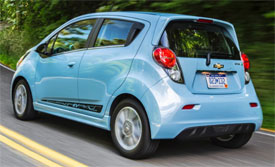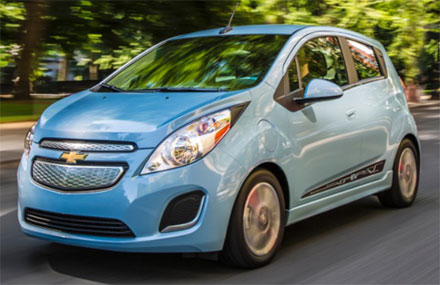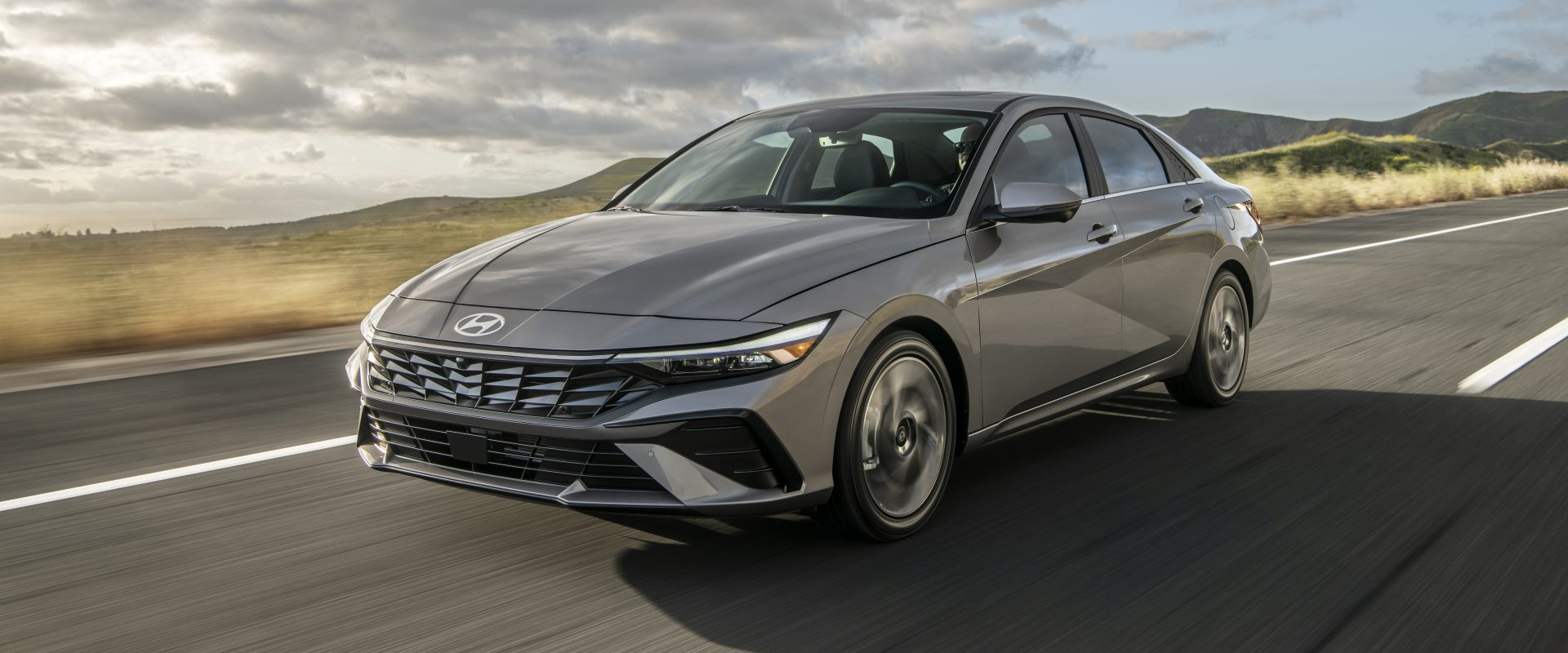2014 Chevrolet Spark EV
It was just last year that Chevrolet introduced their mini car, the spark, to a U.S. market desperately seeking ways to save on gas. And while sales have taken off, it didn’t exactly fan the flames of desire for anyone hoping “performance” and “fun” were part of the equation. Well now there’s an all new, all electric spark, that’s a little more green, and a lot more mean!
…or as “mean” as a mini car can be. But with the Spark stepping into the EV ring, it’ll take on heavy weights like the Nissan Leaf, newcomers like the Fiat 500e, and even plug-ins like Chevy’s own Volt. So it needs as much attitude as it can muster; as efficiency alone just won’t cut it anymore.
Luckily, the powertrain does have attitude; and like Napoleon, the Spark EV is a little car with a lot to prove. Its 21 kilowatt hour Lithium Ion battery pack, mounted low, between the rear wheels, sends juice up front, where an electric motor quietly churns up 105 kilowatts, that’s 140 horsepower and a neck-snapping 400 lb-ft of torque.
 Though we didn’t get to computer clock it, GM says 0-60 time is under 8 seconds and our intro drive certainly felt like it. We even managed to chirp the front tires, as all that torque-y goodness is instantly available from stand still right up to a top speed of 90 MPH. A dedicated Sport mode increases throttle response even more.
Though we didn’t get to computer clock it, GM says 0-60 time is under 8 seconds and our intro drive certainly felt like it. We even managed to chirp the front tires, as all that torque-y goodness is instantly available from stand still right up to a top speed of 90 MPH. A dedicated Sport mode increases throttle response even more.
Efficiency-wise, the Spark EV is on par with other EV rivals, and its estimated 82 mile cruising range in mixed driving felt honest, and attainable. So as long as you plan ahead, you can leave your range anxiety behind.
Adding close to 600 pounds over its gas powered counterpart, the all-electric Spark actually achieves a closer 50/50 front and rear weight distribution. Yet with near double the horsepower and five times the torque output, additional reinforcements were needed throughout the chassis. Specially tuned coil springs for the MacPherson strut front and torsion beam rear suspension were added, as well, and disc brakes to all four corners.
We admit “Fun to Drive” is a clichéd way to describe any driving experience, but it is the truth for the Spark EV. More so than any other electric driver, the Spark has an effortless power delivery, tight, composed ride, and a sporty responsiveness; all of which will help you silently but surely navigate the urban sprawl.
For fans of the original Spark, very little changes outside; and everything that has, was done so in the name of efficiency. Front end design remains the same, with the upper grills now closed off, and active grill shutters below. Aero accents on the side mirrors, fenders, underbody, and on top direct and deflect airflow.
 The interior continues to shine, with its refreshing simplicity now enhanced by a 7-inch LCD digital gauge cluster. Lifted from the Volt, its range-indicating Confidence Gauge adjusts in real time to your driving style and estimates a maximum and minimum range. There are also readouts for power consumption and regeneration, and an integrated trip computer.
The interior continues to shine, with its refreshing simplicity now enhanced by a 7-inch LCD digital gauge cluster. Lifted from the Volt, its range-indicating Confidence Gauge adjusts in real time to your driving style and estimates a maximum and minimum range. There are also readouts for power consumption and regeneration, and an integrated trip computer.
Chevy’s MyLink interface comes standard, on a second 7 inch LCD display in the center stack. In addition to fielding infotainment duties, it provides more detailed readouts of battery charge and vehicle power use. Seats on 1LT trim are cloth, with leatherette for the top 2LT. All the goodies, like satellite radio, Bluetooth, and heated seats come standard. Cargo room is down slightly, to 23.4 cubic feet with the rear seats folded.
Government Fuel Economy ratings for the Spark EV are, of course, not really needed, as there’s no traditional fuel consumed or emissions released. But the equivalent combined rating is a lofty 119 MPGe.
Charging is standard fare, with a 120 volt trickle charger included, 240 volt capability, and the availability of the segment’s first SAE approved DC combo Fast Charger, capable of an 80 percent charge in 20 minutes. We estimate a cost of around $2.50 per home recharge.
Currently only available in California and Oregon, the 2014 Chevrolet Spark EV in base 1LT trim begins at $27,495. But, government incentives drop that below the 20 grand mark. More importantly, monthly leases are available for as little as $199.
Going EV seems a natural fit for the Chevrolet Spark. And its all-electric powertrain is a monster within the small car segment. So even if its sales don’t start a landslide, it has already accomplished something far greater: making itself, and the EV segment as a whole, impossible to ignore. It’s the most impressive mini-EV you’ve never heard coming!
Specifications
- Horsepower: 140
- Torque: 400 lb-ft
- 0-60 mph: Under 8 seconds
- EPA: Combined rating 119 MPGe
2024 Hyundai Elantra
Basic Transportation At Its Best…And That Is A Compliment
For those of you who write in every week bemoaning the fact that all we seem to do around here is test incredibly expensive cars and EVs that only the very well to do can afford, this one’s for you. It’s a commuter and budget friendly mainstay from Hyundai, the compact Elantra sedan. And, it has been nicely updated for 2024.
We clearly do enjoy driving high-performance machines and ultra-luxury rides around here, but like most of you, when it comes time to drive home at the end of a long workday, we do so in something much more practical and affordable, like this 2024 Hyundai Elantra sedan.
If you’re thinking the front end has gotten more aggressive, you’re right. Hyundai calls it a “Shark Nose” theme, and we’re guessing they were thinking more Great White than Hammerhead, though Megamouth shark would also apply. It helps for a low and wide look; more substantial than the typical compact. Other additions for ’24 include slimmer daytime running lights, revised stainless steel Hyundai emblem, reshaped front fenders, sport sedan-style rear diffuser with silver trim; a parametric pattern added to the C-Pillar, and new LED taillights that take up a lot more space on the highly sculpted decklid. Plus, new wheel designs in sizes ranging from 15- to 18-inches.
Standard engine in SE, SEL, and Limited grades is this naturally aspirated 2.0-liter I4 with 147 horsepower and 132 lb-ft of torque. Even with no hybrid assistance, it gets substantial Government Fuel Economy Ratings of 31 City, 40 Highway, and 34 Combined; we averaged a great 38.6 mpg of Regular.
Those high fuel economy numbers mean acceleration times are pretty high as well. It was in no particular hurry to get off the line at our test track, as after a slight jolt of power, it felt pretty sluggish going down the track, taking us a lengthy 9.4 seconds to hit 60 mph. Hyundai’s Intelligent Variable Transmission has some realistic simulated gear shifts built in, and they not only provided the feel of a true automatic, but kept engine noise from becoming overbearing. And while this 2.0-liter may not be a house-on-fire off the line, it has no problem keeping up with traffic, and feels like just the perfect amount of power for a practical and safe commuter car.
There are other engine options too. Two choices if you want to go faster, a 1.6-liter turbo with 201 horsepower in the Elantra N Line, and a 276-horsepower turbocharged 2.0-liter for the Elantra N; plus, one with even better fuel economy, a 1.6-liter hybrid with a 139 horsepower total output.
And despite some significant understeer, there was good feel through the cones of our handling course, both in steering and chassis feedback. We wouldn’t quite call it “point and shoot,” but it responded to inputs fairly quickly, with only moderate body roll. All-in-all, when it comes to performance, it doesn’t claim to bring a whole lot to the table, but does clearly overachieve with what it does bring.
And Hyundai is always overachieving when it comes to packing in features, yet has found a way of keeping things refreshingly simple with a good mix of touchscreen and manual controls. Lots of space too, both up front in the surprisingly wide front buckets, and in the rear bench with ample room for three. Updates for all Elantra interiors include softer materials on the door panels, upgraded instrumentation and additional charging ports, plus a surround view monitor and new H-Tex simulated leather for Limited trim.
Elantra pricing starts with an SE at $22,775, the SEL comes in at $24,725, Limited begins at $28,215, and the sporty N Line starts at $29,615. If you’re interested in the hybrid, base Blue starts at $27,400 with Limited at $30,600.
Some might say there’s not a whole lot that’s earth shaking about the 2024 Hyundai Elantra, but that’s mostly why we like it so much. When it comes to just delivering good, basic transportation with a high dose of unexpected amenities, Hyundai delivers once again.
Specifications
- Engine: 2.0-liter I4
- Horsepower: 147
- 0-60 mph: 9.4 seconds
- 60-0 Braking: 111 ft (avg)
- MW Fuel Economy: 38.6 MPG (Regular)
- Transmission: IVT
- Torque: 132 lb-ft
- 1/4 Mile: N/A (Track Maintenance)
- EPA: 31 City / 40 Highway / 34 Combined







